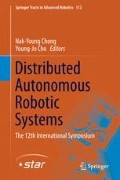Abstract
We study the problems of throughput optimisation of mobile sensor networks. A network of mobile sensor nodes equipped with limited sensing and communication capabilities for connectivity maintenance and measurement of quality of communication links with the nearest neighbours is deployed to exploit and collect environmental data. Communication throughput of the multi-hop ad-hoc network of mobile sensor nodes is maximised for fast and reliable data transmission from sources to destinations. We propose a method of designing the distributed control for mobile sensor nodes for throughput optimisation in two stages: (1) position-aware optimisation and (2) communication-aware optimisation. We demonstrate effectiveness of the method through Monte-Carlo simulation based statistical results.
Access this chapter
Tax calculation will be finalised at checkout
Purchases are for personal use only
References
Tanner, H., Jadbabaie, A., Pappas, G.J.: Stable flocking of mobile agents, part I: fixed topology. In: IEEE Conference on Decision and Control, pp. 2010–2015 (2003)
Tanner, H.G., Jadbabaie, A., Pappas, G.J.: Stable flocking of mobile agents, part II: dynamic topology. In: IEEE Conference On Decision And Control, pp. 2016–2021 (2003)
Kim, D.H., Wang, H., Shin, S.: Decentralized control of autonomous swarm systems using artificial potential functions: analytical design guidelines. J. Intell. Robotic Syst. 45(4), 369–394 (2006)
Ji, M., Egerstedt, M.: Distributed coordination control of multiagent systems while preserving connectedness. IEEE Trans. Robot. 23(4), 693–703 (2007)
Olfati-Saber, R., Murray, R.M.: Consensus problems in networks of agents with switching topology and time-delays. IEEE Trans. Automat. Control 49(9), 1520–1533 (2004)
Olfati-saber, R.: Flocking for multi-agent dynamic systems: algorithms and theory. IEEE Trans. Autom. Control 51, 401–420 (2006)
Dimarogonas, D.V., Kyriakopoulos, K.J.: Connectedness preserving distributed swarm aggregation for multiple kinematic robots. IEEE Trans. Robot. 24(5), 1213–1223 (2008)
Stump, E., Jadbabaie, A., Kumar, V.: Connectivity management in mobile robot teams. In: ICRA, pp. 1525–1530 (2008)
Schwager, M., Rus, D., Slotine, J.J.: Unifying geometric, probabilistic, and potential field approaches to multi-robot deployment. Int. J. Robot. Res. 30(3), 371–383 (2011)
Tu, Z., Wang, Q., Qi, H., Shen, Y.: Flocking based distributed self-deployment algorithms in mobile sensor networks. J. Parallel Distrib. Comput. 72(3), 437–449 (2012)
Khatib, O.: Real-time obstacle avoidance for manipulators and mobile robots. Int. J. Robot. Res. 5(1), 90–98 (1986)
Elkaim, G.H., Kelbley, R.J.: Extension of a lightweight formation control methodology to groups of autonomous vehicles. In: ISAIRAS. Muchen (2005)
Reif, J.H., Wang, H.: Social potential fields: A distributed behavioral control for autonomous robots. Robot. Auton. Syst. (1999)
Spears, D.F., Hamann, J.C., Heil, R.: Distributed, physics-based control of swarms of vehicles. Auton. Robots 17, 137–162 (2004)
Ge, S.S., Fua, C.H.: Queues and artificial potential trenches for multi-robot formations. IEEE Trans. Robot. 21(4), 646–656 (2005)
Andrew Howard, M.J.M., Sukhatme, G.S.: Mobile sensor network deployment using potential fields: A distributed, scalable solution to the area coverage problem. In: Proceedings of the International Symposium on Distributed Autonomous Robotic Systems, pp. 299–308 (2002)
Mikkelsen, S.B., Jespersen, R., Ngo, T.D.: Probabilistic communication based potential force for robot formations: a practical approach. In: DARS, pp. 243–253 (2010)
Grossglauser, M., Tse, D.N.C.: Mobility increases the capacity of ad hoc wireless networks. IEEE/ACM Trans. Netw. 10(4), 477–486 (2002)
de Moraes, R.M., Sadjadpour, H.R., Garcia-Luna-Aceves, J.J.: Mobility-capacity-delay trade-off in wireless ad hoc networks. Ad Hoc Netw. 4(5), 607–620 (2006)
Mostofi, Y.: Decentralized communication-aware motion planning in mobile networks: an information-gain approach. J. Intell. Robot. Syst. 56(1–2), 233–256 (2009)
Ngo, T.D.: Linkmind: link optimization in swarming mobile sensor networks. Sensors 11(8), 8180–8202 (2011)
Seol, J.Y., Kim, S.L.: Node mobility and capacity in wireless controllable ad hoc networks. Comput. Commun. 35(11), 1345–1354 (2012)
Natalizio, E., Loscrì, V.: Controlled mobility in mobile sensor networks: advantages, issues and challenges. Telecommun. Syst. 52(4), 2411–2418 (2013)
Ford, L., Fulkerson, D.: Maximal flow through a network. Can. J. Math. 8, 399–404 (1956)
Haenggi, M.: Analysis and design of diversity schemes for ad hoc wireless networks. IEEE J. Sel. Areas Commun. 23(1), 19–27 (2005)
Liu, X., Haenggi, M.: Throughput analysis of fading sensor networks with regular and random topologies. EURASIP J. Wirel. Commun. Netw. 2005(4), 554–564 (2005)
Fida, A., Iqbal, M., Ngo, T.D.: Communication—and position-aware reconfigurable route optimization in large-scale mobile sensor networks. EURASIP J. Wirel. Commun. Netw. 2014, 207 (2014)
Acknowledgments
This research was supported in part by the University Research Grant (UBD/PNC2/2/RG/1(259)).
Author information
Authors and Affiliations
Corresponding author
Editor information
Editors and Affiliations
Rights and permissions
Copyright information
© 2016 Springer Japan
About this paper
Cite this paper
Ngo, T.D. (2016). Distributed Co-optimisation of Throughput for Mobile Sensor Networks. In: Chong, NY., Cho, YJ. (eds) Distributed Autonomous Robotic Systems. Springer Tracts in Advanced Robotics, vol 112 . Springer, Tokyo. https://doi.org/10.1007/978-4-431-55879-8_29
Download citation
DOI: https://doi.org/10.1007/978-4-431-55879-8_29
Published:
Publisher Name: Springer, Tokyo
Print ISBN: 978-4-431-55877-4
Online ISBN: 978-4-431-55879-8
eBook Packages: EngineeringEngineering (R0)

